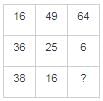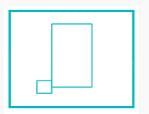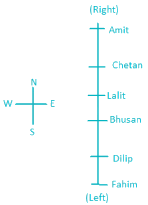Air Force Agniveer Vayu Group Y Mock Test - 10 - Airforce X Y / Indian Navy SSR MCQ
30 Questions MCQ Test - Air Force Agniveer Vayu Group Y Mock Test - 10
Tending to move away from the centre or axis
In the following questions four alternatives are given for the idiom/phrase italicised and underlined in the sentence. Choose the alternative which best expresses the meaning of idiom/phrase.
Q. Do not trust a man who blows his own trumpet.
Directions: In the question given below there are two statements, each statement consists of two blanks. You have to choose the option which provides the correct set of words that fits both the blanks in both the statements appropriately and in the same order making them meaningful and grammatically correct.
I. India is a ________ after destination for medical tourism, but in the area of early screening and intervention it is still ________ behind, and early developmental screening is more the exception than the rule.
II. The minister interacted with the local residents and ________ their feedback on the developmental policies as he wanted to know why the district, which was a knowledge hub earlier, was presently ________ in crucial indicators of development.
Directions: In each of the following questions, there are four sentences or parts of sentences that form a paragraph. Identify the sentence(s) or part(s) of the sentence(s) that is/are correct in terms of grammar and usage (including spelling, punctuation, and logical consistency). Then, choose the most appropriate option.
A. Three years have passed since Dr Ira Kalish, global research head, Deloitte, visited India.
B. But the changes in modern trade are all too apparent to Kalish.
C. There has been well-publicised expansions and scale backs.
D. Some have taken a fall, and others picked pace.
Directions: In each of the following questions, there are four sentences or parts of sentences that form a paragraph. Identify the sentence(s) or part(s) of the sentence(s) that is/are correct in terms of grammar and usage (including spelling, punctuation, and logical consistency). Then, choose the most appropriate option.
A. NRIs does not include a person who has gone out of India on employment, business or vocation.
B. Or any other purpose for an uncertain period.
C. Also, a person who has come to stay in India other than employment.
D. Business or vocation, or on any other purpose for an uncertain period.
He found the gold coin as he cleans the floor.
He admired the speed with which he completed the work and appreciating the method adopted by him
What does the tense of a verb show?
Direction For question : As the Heart of Darkness makes its way into the savage shadows of the African continent, Joseph Conrad exposes a psycho-geography of the collective unconscious in the entangling symbolic realities of the serpentine Congo. Conrad’s novella descends into the unknowable darkness at the heart of Africa, taking its narrator, Marlow, on an underworld journey of individuation, a modern odyssey toward the center of the Self and the center of the Earth. Ego dissolves into soul as, in the interior; Marlow encounters his double in the powerful image of ivory-obsessed Kurtz, the dark shadow of European imperialism. The dark meditation is graced by personifications of anima in Kurtz’ black goddess, the savagely magnificent consort of the underworld, and in his porcelain -skinned Persephone, innocent intended of the upper world. “Africa,” wrote Graham Greene, “will always be the Africa in the Victorian atlas, the blank unexplored continent in the shape of the human heart.” The African heart described by Greene “acquired a new layer of meaning when Conrad portrayed the Congo under King Leopold as the Heart of Darkness, a place where barbarism triumphs over humanity, nature over technology, biology over culture, id over super ego.” The unknown and uncharted topography of the African continent first beckoned Conrad’s narrator, Marlow, into its depths in his boyhood: “Now, when I was a little chap I had a passion for maps. I would look for hours at South America, or Africa, or Australia, and lose myself in all the glories of exploration”. When Marlow was grown and Africa was no longer a blank space on the map, but rather “a place of darkness,” there was still one river there that drew him especially, “a mighty big river, that you could see on the map, resembling an immense snake uncoiled, with its head in the sea, its body at rest curving afar over a vast country, and its tail lost in the depths of the land”. This same deep place, the Congo, that had seduced Conrad’s ivory hunting Kurtz into the horrors of its savage embrace had, in 1890, lured Conrad himself into adventure that turned him from sailor to writer and severely affected his health for the rest of his life. As the voyage up the Congo pro ved fateful for the development of Conrad’s narrator, Marlow, it was equally fateful for Conrad’s individuation, as he reflects in his letters “Before the Congo I was just a mere animal.” Hillman, in “Notes on White Supremacy” reminds us that, like Conrad, both Freud and Jung were called to venture into the shadowed continent and vestiges of their journeys still colour our psychological language: The convention informing geographical discoveries and the expansion of white consciousness over Africa continue to inform psychic geography. The topological language used by Freud for “the unconscious” as a place below, different, timeless, primordial, libidinal and separated from the consciousness recapitulates what white reporters centuries earlier said about West Africa. From Conrad’s Heart of Darkness to van der Post’s Venture to the Interior, Africa and the unconscious allegorize the other place.... “Just don’t stay in the topical colonies too long; you must reign at home,” writes Freud in 1911 to Jung, who himself made the African journey fourteen years later, describing the vast lands and dark peoples he encountered in language he applies as well to the immemorial unconscious psyche.... Part of psychology’s myth is that the unconscious was “discovered” as its contents are “explored”. Thus Africa has become a topology of the mind — its location, its shape, its cultures, its textures, its rhythms, its foliage, its hues, its wildness — all calling forth something lost in the psychology of the white European. It is with an understanding of our destiny to explore that symbolic lost continent within ourselves that we can begin to appreciate the prescience of Jungian psychology in Conrad’s Heart of Darkness.
Q. Which of the following is not in alliance with the representation of ‘Africa’ as in Conrad’s Heart of Darkness?
(a) Conrad portrays Africa (Congo) as being inhibited by people who are primitive and uncivilized.
(b) Civilization is shown to be non-existent in the depths of Africa.
(c) Africa is portrayed as a place full of delights and charms, which attracts the attention of Marlow.
Direction For question : As the Heart of Darkness makes its way into the savage shadows of the African continent, Joseph Conrad exposes a psycho-geography of the collective unconscious in the entangling symbolic realities of the serpentine Congo. Conrad’s novella descends into the unknowable darkness at the heart of Africa, taking its narrator, Marlow, on an underworld journey of individuation, a modern odyssey toward the center of the Self and the center of the Earth. Ego dissolves into soul as, in the interior; Marlow encounters his double in the powerful image of ivory-obsessed Kurtz, the dark shadow of European imperialism. The dark meditation is graced by personifications of anima in Kurtz’ black goddess, the savagely magnificent consort of the underworld, and in his porcelain -skinned Persephone, innocent intended of the upper world. “Africa,” wrote Graham Greene, “will always be the Africa in the Victorian atlas, the blank unexplored continent in the shape of the human heart.” The African heart described by Greene “acquired a new layer of meaning when Conrad portrayed the Congo under King Leopold as the Heart of Darkness, a place where barbarism triumphs over humanity, nature over technology, biology over culture, id over super ego.” The unknown and uncharted topography of the African continent first beckoned Conrad’s narrator, Marlow, into its depths in his boyhood: “Now, when I was a little chap I had a passion for maps. I would look for hours at South America, or Africa, or Australia, and lose myself in all the glories of exploration”. When Marlow was grown and Africa was no longer a blank space on the map, but rather “a place of darkness,” there was still one river there that drew him especially, “a mighty big river, that you could see on the map, resembling an immense snake uncoiled, with its head in the sea, its body at rest curving afar over a vast country, and its tail lost in the depths of the land”. This same deep place, the Congo, that had seduced Conrad’s ivory hunting Kurtz into the horrors of its savage embrace had, in 1890, lured Conrad himself into adventure that turned him from sailor to writer and severely affected his health for the rest of his life. As the voyage up the Congo pro ved fateful for the development of Conrad’s narrator, Marlow, it was equally fateful for Conrad’s individuation, as he reflects in his letters “Before the Congo I was just a mere animal.” Hillman, in “Notes on White Supremacy” reminds us that, like Conrad, both Freud and Jung were called to venture into the shadowed continent and vestiges of their journeys still colour our psychological language: The convention informing geographical discoveries and the expansion of white consciousness over Africa continue to inform psychic geography. The topological language used by Freud for “the unconscious” as a place below, different, timeless, primordial, libidinal and separated from the consciousness recapitulates what white reporters centuries earlier said about West Africa. From Conrad’s Heart of Darkness to van der Post’s Venture to the Interior, Africa and the unconscious allegorize the other place.... “Just don’t stay in the topical colonies too long; you must reign at home,” writes Freud in 1911 to Jung, who himself made the African journey fourteen years later, describing the vast lands and dark peoples he encountered in language he applies as well to the immemorial unconscious psyche.... Part of psychology’s myth is that the unconscious was “discovered” as its contents are “explored”. Thus Africa has become a topology of the mind — its location, its shape, its cultures, its textures, its rhythms, its foliage, its hues, its wildness — all calling forth something lost in the psychology of the white European. It is with an understanding of our destiny to explore that symbolic lost continent within ourselves that we can begin to appreciate the prescience of Jungian psychology in Conrad’s Heart of Darkness.
Q. According to the passage, which of the following is not true about The Congo?
Direction For question : As the Heart of Darkness makes its way into the savage shadows of the African continent, Joseph Conrad exposes a psycho-geography of the collective unconscious in the entangling symbolic realities of the serpentine Congo. Conrad’s novella descends into the unknowable darkness at the heart of Africa, taking its narrator, Marlow, on an underworld journey of individuation, a modern odyssey toward the center of the Self and the center of the Earth. Ego dissolves into soul as, in the interior; Marlow encounters his double in the powerful image of ivory-obsessed Kurtz, the dark shadow of European imperialism. The dark meditation is graced by personifications of anima in Kurtz’ black goddess, the savagely magnificent consort of the underworld, and in his porcelain -skinned Persephone, innocent intended of the upper world. “Africa,” wrote Graham Greene, “will always be the Africa in the Victorian atlas, the blank unexplored continent in the shape of the human heart.” The African heart described by Greene “acquired a new layer of meaning when Conrad portrayed the Congo under King Leopold as the Heart of Darkness, a place where barbarism triumphs over humanity, nature over technology, biology over culture, id over super ego.” The unknown and uncharted topography of the African continent first beckoned Conrad’s narrator, Marlow, into its depths in his boyhood: “Now, when I was a little chap I had a passion for maps. I would look for hours at South America, or Africa, or Australia, and lose myself in all the glories of exploration”. When Marlow was grown and Africa was no longer a blank space on the map, but rather “a place of darkness,” there was still one river there that drew him especially, “a mighty big river, that you could see on the map, resembling an immense snake uncoiled, with its head in the sea, its body at rest curving afar over a vast country, and its tail lost in the depths of the land”. This same deep place, the Congo, that had seduced Conrad’s ivory hunting Kurtz into the horrors of its savage embrace had, in 1890, lured Conrad himself into adventure that turned him from sailor to writer and severely affected his health for the rest of his life. As the voyage up the Congo pro ved fateful for the development of Conrad’s narrator, Marlow, it was equally fateful for Conrad’s individuation, as he reflects in his letters “Before the Congo I was just a mere animal.” Hillman, in “Notes on White Supremacy” reminds us that, like Conrad, both Freud and Jung were called to venture into the shadowed continent and vestiges of their journeys still colour our psychological language: The convention informing geographical discoveries and the expansion of white consciousness over Africa continue to inform psychic geography. The topological language used by Freud for “the unconscious” as a place below, different, timeless, primordial, libidinal and separated from the consciousness recapitulates what white reporters centuries earlier said about West Africa. From Conrad’s Heart of Darkness to van der Post’s Venture to the Interior, Africa and the unconscious allegorize the other place.... “Just don’t stay in the topical colonies too long; you must reign at home,” writes Freud in 1911 to Jung, who himself made the African journey fourteen years later, describing the vast lands and dark peoples he encountered in language he applies as well to the immemorial unconscious psyche.... Part of psychology’s myth is that the unconscious was “discovered” as its contents are “explored”. Thus Africa has become a topology of the mind — its location, its shape, its cultures, its textures, its rhythms, its foliage, its hues, its wildness — all calling forth something lost in the psychology of the white European. It is with an understanding of our destiny to explore that symbolic lost continent within ourselves that we can begin to appreciate the prescience of Jungian psychology in Conrad’s Heart of Darkness.
Q. The author compares Congo to an animal/a reptile. What is this figure of speech called?
Which answer figure will complete the pattern in the question figure?

From the given answer figures, select the one in which the question figure is hidden/embedded.

A piece of transparent paper is folded. Find how the pattern appears when the paper is folded along the dotted line.

If a mirror is placed on the line MN, then which of the answer figures is the right image of the given figure?

If o < l, x < o, a < l and p < o, which of the following must be true?
I. a > p
II. l > p
III. x < l
If '+' is 'x', '-‘ is '+', 'x' is '÷' and '÷' is '-‘, then answer the following question based on this information.
13.5 x 1.5 - 0.008 + 125 = ?
In the following question, select the missing number from the given alternatives.

Directions: In question, two statements are given followed by conclusion. You have to consider the statement to be true even if it seems to be at variance from commonly known facts. You are to decide which of the given conclusion can definitely be drawn from the given statement. Indicate your answer.
Statements:
(I) Some students are intelligent.
(II) Ankita is a student.
Conclusions:
1. Some students are dull.
2. Ankita is intelligent.
Amit, Bhuwan, Chetan, Lalit, Dilip and Fahim are sitting in a row facing west. Chetan is between Amit and Lalit. Bhuwan is just to the left of Lalit but right of Dilip. Chetan sitting to the immediate right of Lalit. Fahim is at the extreme left end. Which pair is sitting by the sides of Dilip?
Directions: In question, which answer figure will complete the question figure?

If A @ B means A is father of B, A # B means A is brother of B and A ! B means A is grandson of B, then what does P @ Q # R ! S mean?
A piece of paper is folded and punched as shown below in the question figures. From the given answer figures, indicate how it will appear when opened.

Directions: In the question below are three statements followed by three conclusions numbered I, II and III. You have to take the three given statement to be true even if they seem to be at variance from commonly known facts and then decide which of the given conclusion logically follows from the three given statements, disregarding commonly known facts.
Statements:
Some rivers are hills.
No hills are taxi.
All taxi are buses.
Conclusions:
I. Some buses are rivers.
II. Some rivers are definitely not taxi.
III. No bus is river.
Which of the following is Study of fossils?
Sour taste of lemon is due to the presence of which of the following?
Which State has the longest coastline?
The term 'Smasher' is associated with which sport?
The longest railway line in the world connects _________



























